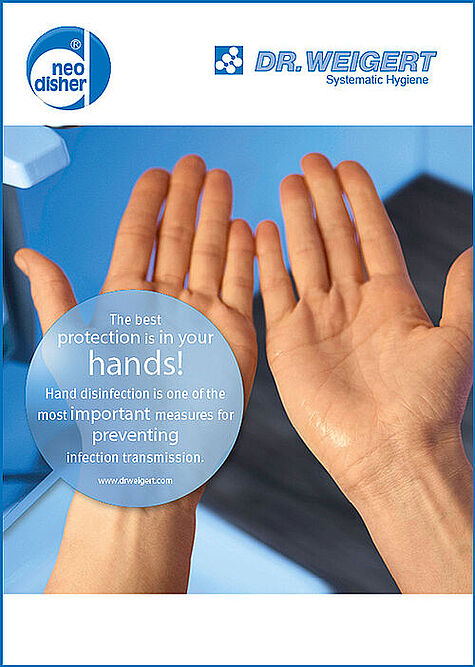Norovirus infections can occur all the year round but the rate of infections increases in the winter months from October until March. According to the RKI, the beginning of the “norovirus season” was unexpectedly early and very intensive in 2016. In November 2016, 14,519 cases of norovirus infection were reported to the RKI in Germany. That was more than 7,000 cases above the average of the previous five years.*
Noroviruses are the main cause for gastric diseases in single cases as well as in epidemic cases in community facilities such as schools, hospitals, etc. Especially elderly or immunocompromised people are very vulnerable to norovirus infections, which can end fatally in single cases.
Transfer and course of a norovirus infection:
Noroviruses can be transferred directly via human contact as well as indirectly via contaminated objects or food. An amount of 10 – 100 pathogens can be enough to contract an infection, also in entirely healthy people. A norovirus infection starts after an incubation period of 10 – 50 hours and causes violent nausea and vomiting, and diarrhoea. Especially in the acute stage and at least 48 hours after the last symptoms, patients are potentially infectious. Furthermore, the virus can be egested 7-14 days and up to several weeks after the acute stage. The accurate maintenance of general hygiene procedures even after the outbreak is very important.**
Procedures:
To prevent the transfer of noroviruses the chain of infection needs to be interrupted. One of the most important prophylaxis procedures is hygienic disinfection. Dr. Weigert recommends following products, which are active against noroviruses:
triformin® safeDIS for the food industry
- For hygienic hand disinfection
- Bactericidal, yeasticidal, virucidal incl. norovirus
- With skin care component and re-moisturising components
- Free of colouring agents and perfumes
weigoman® or weigoman® parfümfrei*** for use in areas near patients
- For hygienic and surgical hand disinfection
- Bactericidal, tuberculocidal, fungicidal, active against enveloped viruses, active against rotavirus and norovirus
- With skin care component and re-moisturising components
- Also applicable during pregnancy and lactation
For hygienic hand disinfection, the hand disinfectant is rubbed undiluted into the hands so that the entire surface of the hands including the problem areas (e.g. under fingernails) are completely wetted. The rubbing method for hygienic hand disinfection according to the European standard EN 1500 offers assistance in covering the entire surface of the hands.****
*Median of the 5 previous years: 7,810.
Source: www.rki.de/DE/Content/Infekt/EpidBull/Archiv/2016/Ausgaben/50_16.pdf, (17.02.2017)
**Source: www.rki.de/DE/Content/Infekt/EpidBull/Merkblaetter/Ratgeber_Noroviren.html, (17.02.2017)
***weigoman® / weigoman® parfümfrei: Composition: 100 g solution for application on the skin contains 63.14 g 2-propanol and 14.3 g 1-propanol. Excipients: Purified water, glycerol, butane-1,3-diol, lanolin-poly(oxyethylene)-75. Additionally in weigoman: perfume oil Fresh. Fields of application: Hygienic and surgical hand disinfection. Contraindications: Hypersensitivity to the active substances or to any of the excipients. Do not apply to the area near the eyes, mucous membranes or open wounds. Side effects: Dehydration of the skin (flaking, redness, tension, itching) with repeated use. Allergic reactions on contact with the skin or hypersensitivity reactions are possible. Warnings: Contains wool wax. Pharmaceutical entrepreneur: Chemische Fabrik Dr. Weigert GmbH & Co. KG, Mühlenhagen 85, 20539 Hamburg. Last updated: May 2017
****Source: DIN EN 1500 (2013): Chemical disinfectants and antiseptics, hygienic hand disinfection. Test methods and requirements (phase 2 / step 2).
Widespread and highly infectious – efficient hygiene procedures against noroviruses
